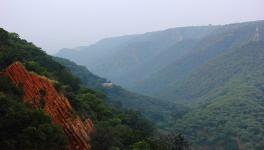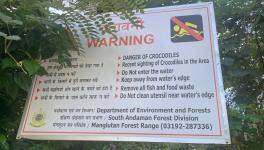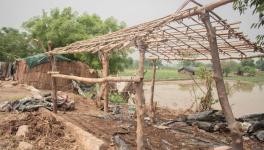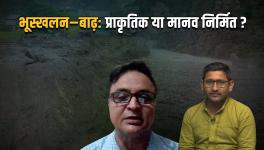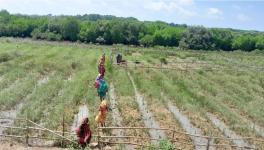Disasters Built Into how we Work, Say Experts on Monsoon Tragedy in Hill States
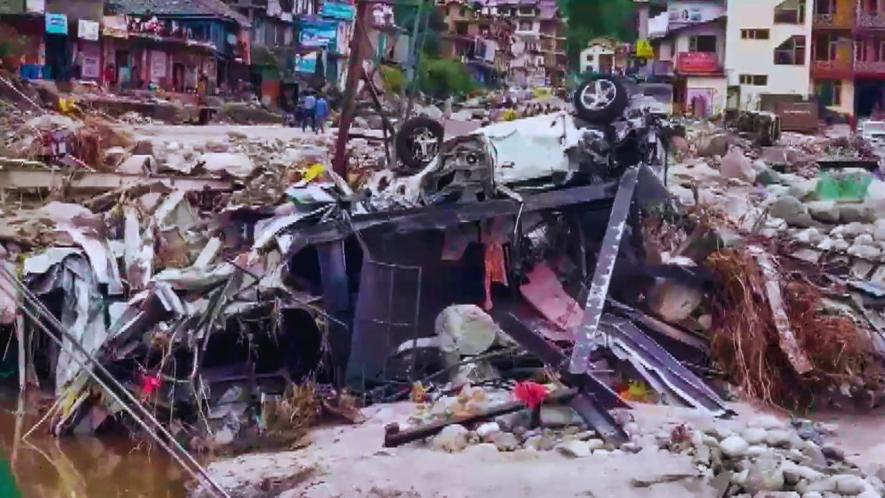
Kullu: A damaged vehicle amid debris following recent flash floods triggered by cloud burst in Kullu district, Thursday, July 13, 2023. (PTI Photo)
This year’s devastation during the rainy season in Himachal Pradesh and Uttarakhand has been precipitated by intense construction activities like road widening, dam construction and other poorly planned activities, which weakened the hill slopes and triggered major landslides. The problems were only compounded by the torrential rainfall led by rising temperatures.
The magnitude of the disaster in these two hill states is unprecedented. Crucial road links between Kalka and Shimla, Kullu and Manali, Chandigarh and Manali, Manali and Leh, Dehradun and Haridwar, etc., have been disrupted as roads caved in or landslides occurred. A total of 170 routes had to be closed in Uttarakhand alone.
Bridges have been swept away, and the under-construction Ramban tunnel in Jammu and Kashmir has been blocked again, with several labourers trapped. Last year as well, a significant portion of this tunnel collapsed, killing a number of workers.
Even more alarming are reports from villages around Munsyari in the Nanda Devi Biosphere, whose locals took to social media to say the Bagini Glacier has burst. They suspect it happened because of the volume of water flowing in the Junna Nala. There is no official confirmation of such a development yet.
Government sources claim that once the rainfall recedes, a team of scientists will substantiate whether this happened.
According to locals, a spurt of road construction destabilised the Munsyari Glacier near the Indo-China border. They claim the number of tourists trekking the Bagini Glacier has been rising, contributing to haphazard construction.
Geologist Dr CP Rajendran had repeatedly warned that floods have become a recurrent phenomenon in the Himalayan region. They are bringing immense devastation to villages and towns near rivers, as witnessed during the 2013 floods that destroyed Kedarnath, Gaurikund and other villages in this region.
“Increased footfall due to commercial tourism in the hills with government encouragement and rapid infrastructure construction to support this inflow has impacted the micro-environmental conditions. This region already had to deal with forest fires, deforestation, loss of water sources and soil losses. It was obvious they could no longer bear the brunt of unregulated anthropogenic activity,” says Dr Rajendran.
The government was unwilling even to consider this view. Environmentalist and scientist Dr Ravi Chopra, director of the People’s Science Institute, had hoped that he and his team would contribute to protecting the Himalayas when he was appointed chairman of the Supreme Court’s high-powered committee to oversee the construction of the Char Dham road.
Two months into his new role, Chopra realised the government machinery, comprising the National Highway Authority of India (NHAI) and the Ministry of Road Transport and Highways, and their bureaucrats, engineers and contractors, were not interested in his suggestions. In retrospect, the government may have mitigated the scale of the disaster if it had listened to the experts.
Dr Chopra says, “The Himalayan region is geologically, seismically and ecologically very sensitive. Any infrastructure development activity must respect the constraints imposed by geology, seismic conditions and the ecology of this area.”
“Extreme events due to climate change have added a new dimension to existing hazards. Current infrastructure projects ignore these constraints. Sadly, the local ecology and people pay for developers’ callousness and hubris,” he says.
Jawaharlal Nehru University physicist Dr Vikram Soni, who has closely studied the river systems of North India, repeatedly emphasised the need to ban construction on the flood plains completely. “The Sutlej and Beas have wreaked so much havoc because indiscriminate construction was allowed on their flood plains. During the monsoon, when the river flow increases, so does its velocity. The situation is worsened with the dumping of debris and other muck from road construction,” Soni says.
He believes weather patterns have changed, and the western disturbances should be referred to as monsoons arriving from the west. The same phenomenon caused widespread flooding in Pakistan last year. He says the Karakoram glaciers spanning Pakistan, China and India are expanding while the Himalayan glaciers are shrinking. “The water has to come from somewhere, and it is from the increased rainfall from the western disturbances,” Soni says.
Award-winning architect Gautam Bhatia says China has also experienced unprecedented flooding in the last few years. “Our rivers are tiny streams compared to rivers in China, but our problem is faulty environmental clearances and poor engineering design,” says Bhatia.
He says, “The Char Dham road project should never have been sanctioned. Many such four-lane highways cutting across Himachal Pradesh should not have been built because they are creating beachheads in which water collects. The government uses the Army Engineering Corps to replace old bridges, but the new ones are based on the same design, although the conditions are very different today. The traffic load has increased, nor have the designs been worked out to counter growing environmental challenges.”
Bhatia says the problem is elections dictate the planning agenda in India. “In the last 15 or 20 years, Indian cities and landscapes have been destroyed, highways have become commercial zones with shops on either side that defeat the purpose of fast-track roads. Such practices are not allowed anywhere in the world,” he says.
Comparing India’s scale of construction with China’s, he says, “Chinese infrastructure is ten times larger than India’s, but they follow ecological standards. In India, the central government decides what has to be done, and the states must follow its guidelines. The whole point of making roads here is to earn huge kickbacks—our disasters are built into the way we work.”
For instance, he says, India is still pursuing the United States’ highway construction spree, a model it followed in the 20th century, and while the world’s focus has shifted to rail travel and building shipping lanes, India did not move with the times.
Architect Sandeep Kumar, who runs Plural Design Consultants, is horrified at how the government could allow ecologically unsound construction in the Himalayas. “It is a young mountain chain which has not stabilised. Climate change coupled with corrupt practices has created a situation where things can only worsen in the future,” says Kumar.
Dehradun-based environmentalist Reenu Paul has repeatedly warned that cities on the foothills of the Himalayas, such as Haldwani, Rishikesh, Haridwar, Parwanoo, Chandigarh and Mohali, never witnessed such massive floods as this past week.
Paul says, “The foothills were natural drainage for the valleys and hills. Once encroachments on rivulets, streams and springs went unchecked, people ended up blocking water channels. Water needs an outlet during heavy rainfall, but since no outlet exists now, there are floods,” she says.
Scientists at the Wadia Institute of Himalayan Geology have repeatedly warned that 51% of Uttarakhand has crossed the “very high susceptibility zone”. Therefore landslides will increase, as will flooding. These scientists have documented Uttarakhand’s 300-plus landslides in 2023. In such a situation, even mitigation measures will not work.
Rajendran agrees: “Many recommendations for sustainable development were given, but all were ignored. The government should earnestly consider these suggestions now, so that some amelioration can be done. If we allow the business-as-usual attitude, the severity of floods will likely intensify in the coming years,” he says.
To Dr Chopra, such a dire situation can be reversed “only to an extent”. “The slopes could be made safer, but the soil that has been washed away is not replaceable, and vegetation cannot grow on bare rocks,” he says.
But is the present government at least on a learning curve? Sadly, despite assets worth lakhs of crores washed away over just a week, and 75 deaths, the government’s neo-liberal policies will keep costing the environment and people.
The government wants to amend the Forest Conservation Act 1980 in the Monsoon Session of Parliament to de-reserve lakhs of hectares of green areas that are deemed forests. It only shows a lack of commitment to the environment and livelihoods of citizens. Forests are vital to mitigating climate change. Sadly, whatever little of them is left seems to face the axe. For the people of the hill states, the future looks dark.
The author is an independent journalist. The views are personal.
Get the latest reports & analysis with people's perspective on Protests, movements & deep analytical videos, discussions of the current affairs in your Telegram app. Subscribe to NewsClick's Telegram channel & get Real-Time updates on stories, as they get published on our website.









